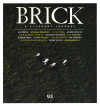Brick – Winter 2014
Have financial constraints or a lack of vacation days turned you into a regionalist against your will? Don’t fret, the new issue of Brick is here to take you on a whirlwind tour, sans pat downs, turbulence, and the high cost of airfare. Aptly labeled “an anthology of enthusiasms” by former editor Michael Ondaatje, Brick is filled with the work of writers and thinkers whose preoccupations are as categorically eclectic as they are geographically diverse. From the ice fields of the North Pole to a paradise in the mind, from Tokyo to Arizona’s San Rafael Valley, the latest issue of Brick gathers the essays, interviews, letters, travelogues, poetry, fiction, reviews and musings of writers eager to give you a guided tour of their personal enthusiasms. And while the magazine’s content is eclectic and truly international in scope, it’s never willfully obscure. Rather, Brick’s eclecticism feels like an extension of its editors’ trust in the ability of good writers to determine what is substantial for themselves and make that substance meaningful and entertaining to others.
Have financial constraints or a lack of vacation days turned you into a regionalist against your will? Don’t fret, the new issue of Brick is here to take you on a whirlwind tour, sans pat downs, turbulence, and the high cost of airfare. Aptly labeled “an anthology of enthusiasms” by former editor Michael Ondaatje, Brick is filled with the work of writers and thinkers whose preoccupations are as categorically eclectic as they are geographically diverse. From the ice fields of the North Pole to a paradise in the mind, from Tokyo to Arizona’s San Rafael Valley, the latest issue of Brick gathers the essays, interviews, letters, travelogues, poetry, fiction, reviews and musings of writers eager to give you a guided tour of their personal enthusiasms. And while the magazine’s content is eclectic and truly international in scope, it’s never willfully obscure. Rather, Brick’s eclecticism feels like an extension of its editors’ trust in the ability of good writers to determine what is substantial for themselves and make that substance meaningful and entertaining to others.
Their faith in the power of good writing pays dividends in British writer Geoff Dyer’s essay “Lessons of Darkness and Other Lessons.” Dyer’s essay, which originally served as the introduction to a catalogue for an exhibition on Arctic photography, deals with the hypnotic power of the photographs taken by the original Arctic explorers, photographs he shrewdly likens to, “A stash of stills from a lost Herzog film in which the documentary sublime and the painstakingly fictive are impossible to distinguish.” Paired with mind-bending and time-ravaged photographs from the lost expedition of Salomon August Andrée, Dyer’s articulate observations come startlingly close to conveying the ineffable qualities of the photographs themselves, qualities that makes it “seem . . . as if the place itself somehow achieved the means to record and preserve the bizarre activities of the people visiting it.” Dyer’s lucid response to the surreal murk of these photographs would make Herzog proud.
In his short essay “Trailer Monasticism,” John Melillo ponders the peculiar resonance of images both real and imagined. He compares an abstract painting by Paul Klee with his own youthful desire of one day living in a trailer in the middle of nowhere doing nothing but reading books, a dream Melillo remembers as the first time he ever “gave concrete shape to an abstract impulse.” In the short span of a couple pages, Melillo manages to create a stirring meditation on the function of the contingent in life and art.
Equally fascinating was Forrest Gander’s interview with influential Japanese photographer Eikoh Hosoe. In the interview, Hosoe, who is best known for a series of photographs he took with Japanese writer Yukio Mishima entitled Ordeal by Roses, gives a detailed and fascinating account of his first photo session with the enigmatic author. Gander’s familiarity with Hosoe’s life and work helped make the interview an engaging blend of biographical detail and art theory, providing a compelling introduction to a photographer I knew very little about.
Given Ondaatje’s description of Brick as “an anthology of enthusiasms,” it’s easy to see why Jim Harrison, a man well known for his enthusiasms both literary and otherwise, has taken up permanent residency as a contributor to the magazine. Harrison’s indomitable personality and supreme confidence as a storyteller are on full display in his short story “Gramps le Fou.” The tale of an aging writer’s struggle to cope with the troublesome effects of all the “brain junk” he’s accumulated during his exhausting life-long struggle to translate experience into the written word, Harrison’s story brims with insights both comic and cosmic:
He had told the neurologist that it would be nice if he could get up in the morning, start the coffee, and slice a mango without saying, “Dawn found him carving a mango.” The neurologist seemed slightly alarmed and wanted to make an appointment for him with a psychiatrist.
Ostensibly a quest story, the protagonist’s hike through an Arizona canyon in an attempt to find a lost dog collar provides him with a chance to digress, in true Harrisonian fashion, on matters existential, prosaic, and sexual.
The writers in Brick seem bent on pulling together disparate ideas in much the same way as Harrison’s protagonist. The magazine is full of entertaining and enlightening digressions from writers trying to organize or at the very least itemize their own “brain junk.” Having just finished reading Brick’s latest issue, I have to say that I feel a bit like a flea market myself.
[www.brickmag.com]





